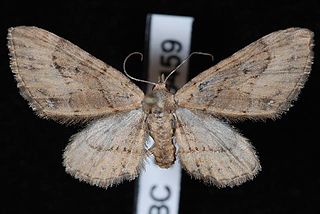
Olene mendosa, the brown tussock moth or hairy tussock moth, is a moth of the family Erebidae. The species was first described by Jacob Hübner in 1823. It is found in India, Bangladesh, Sri Lanka, Indonesia, Taiwan, Thailand and Australia.

Ptycholoma lecheana, the Leche's twist moth, is a moth of the family Tortricidae. It is found in Europe, China, Korea, Japan, Russia and Asia Minor.

Spoladea recurvalis, the beet webworm moth or Hawaiian beet webworm, is a species of moth of the family Crambidae. It is found worldwide, but mainly in the tropics.

Conistra rubiginea, the dotted chestnut, is a moth of the family Noctuidae. The species was first described by Michael Denis and Ignaz Schiffermüller in 1775. It is distributed in Europe and, according to William Warren, Armenia and Asia Minor.

Achyra affinitalis, the cotton web spinner, is a moth of the family Crambidae. It was described by Julius Lederer in 1863 and is found in Australia and New Zealand.

Hyalobathra is a genus of moths of the family Crambidae. The genus was erected by Edward Meyrick in 1885.
Pamphlebia is a monotypic moth genus in the family Geometridae described by Warren in 1897. Its only species, Pamphlebia rubrolimbraria, was first described by Achille Guenée in 1857. It is found in Sri Lanka, Borneo, Indonesia, Taiwan and Australia.

Parosteodes is a monotypic moth genus in the family Geometridae described by Warren in 1895. Its only species, Parosteodes fictiliaria, the dodonaea moth, was first described by Achille Guenée in 1857. It is found in Australia.

Panacela lewinae, or Lewin's bag shelter moth, is a moth of the family Eupterotidae. The species was first described by John Lewin in 1805. It is found in Australia from southern Queensland to southern New South Wales.

Hellula undalis, the cabbage webworm or Old World webworm, is a moth of the family Crambidae. It is a widespread species which is found from Europe across Asia to the Pacific. It was first described from Italy.

Diaphania indica, the cucumber moth or cotton caterpillar, is a widespread but mainly Old World moth species. It belongs to the grass moth family, and therein to the large subfamily Spilomelinae. This moth occurs in many tropical and subtropical regions outside the Americas, though it is native to southern Asia; it is occasionally a significant pest of cucurbits and some other plants.
Hellinsia unicolor is a moth of the family Pterophoridae described by William Barnes and James Halliday McDunnough in 1913. It is found in North America, including Florida, Mississippi, Georgia and Kentucky.

Glyphodes negatalis, the karanj defoliator, is a moth of the family Crambidae. The species was first described by Francis Walker in 1859. It has a wide range in the tropics, including South Africa, The Gambia, Mali, India, Sri Lanka, Hong Kong, Japan, and eastern Australia.

Haritalodes derogata, the cotton leaf roller or okra leaf roller, is a species of moth of the family Crambidae. It was described by Johan Christian Fabricius in 1775. It is widely distributed. Records include the Comoros, the Democratic Republic of the Congo, Ghana, Mali, Réunion, Madagascar, the Seychelles, South Africa, the Gambia, Australia, Fiji, Papua New Guinea, Samoa, the Solomon Islands, the Andaman Islands, Bali, India, Sri Lanka, Malaysia, Myanmar, Singapore, Sri Lanka, Vietnam, China and Japan. It is sometimes encountered in Europe, due to accidental import.

Eupithecia unicolor is a moth in the family Geometridae. It is found from British Columbia south to California.

Hyalobathra archeleuca is a moth in the family Crambidae. It was described by Edward Meyrick in 1885. It is found in Australia, where it has been recorded from New South Wales and Queensland.
Hyalobathra crenulata is a moth in the family Crambidae. It was described by Hari Sutrisno and Marianne Horak in 2003. It is found in Australia, where it has been recorded from Queensland.
Hyalobathra minialis is a moth in the family Crambidae. It was described by Warren in 1895. It is found in Australia, where it has been recorded from Queensland.
Hyalobathra miniosalis is a moth in the family Crambidae. It was described by Achille Guenée in 1854. It is found in India, Indonesia (Java) and Australia, where it has been recorded from Queensland, the Northern Territory and Victoria.
Agrioglypta excelsalis is a moth in the family Crambidae described by Francis Walker in 1866. It is found on Sulawesi, Lifou Island, as well as in Bhutan, Thailand, Sumatra, Papua New Guinea, Samoa and in Australia, where it has been Western Australia, Queensland and northern New South Wales.













